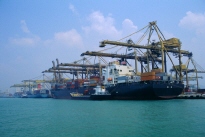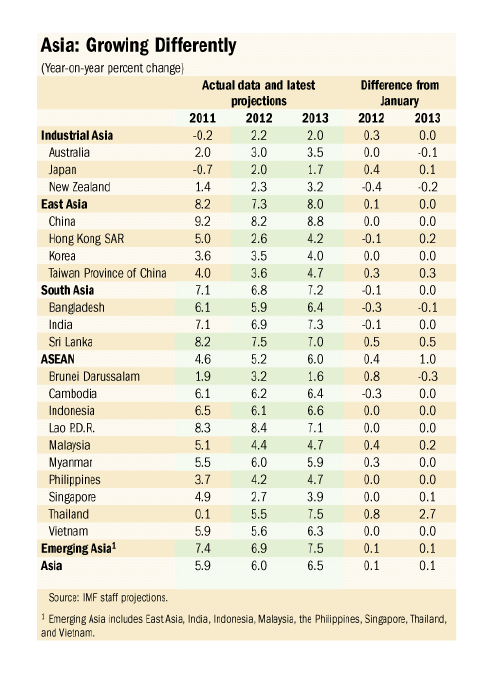
Typical street scene in Santa Ana, El Salvador. (Photo: iStock)
IMF Survey: Asia Faces Stronger Growth, but Further Rebalancing Critical
April 27, 2012
- Asian policymakers need flexibility to support non-inflationary growth
- Euro debt crisis remains lingering threat
- Continued rebalancing, best insurance against external shocks
Growth in Asia is expected to pick up this year, after slowing in the last quarter of 2011, but Asian leaders now face the difficult task of adjusting policies to support stable, non-inflationary growth, say IMF economists.

Containers ship in Singapore harbor. A sharp fall in exports could severely impact activity in Asia (photo: Fraser Hall/Robert Harding World Imagery/Corbis)
ASIA ECONOMIC OUTLOOK
At the launch in Kuala Lumpur, Malaysia, of the IMF’s regular outlook for the Asia Pacific region, the economists said that the region is expected to continue growing at around 6 percent this year, before rebounding in 2013.
“Calibrating the right amount of insurance to support stable, non-inflationary growth is the main near-term policy challenge,” said Anoop Singh, head of the IMF’s Asia and Pacific Department.
“Policymakers should be ready to shift gears and renew tightening if overheating pressures become evident,” he added.
Robust domestic demand
Asia has continued to enjoy robust domestic demand against the background of the fragile global recovery. This has been reflected in low unemployment and robust credit growth in the region. Inflation expectations also picked up and so far, capital inflows into emerging Asia have rebounded in 2012.
The IMF forecasts regional growth will be 6 percent this year, roughly the same level as in 2011, and about 6½ percent in 2013. But there remains considerable regional variation. While emerging Asia will remain the fastest growing region in the world, led by China and India, expanding at 6.9 percent this year, industrial Asia is projected to grow only at 2.2 percent.

A further stabilization of global economic and financial conditions over the course of 2012 would provide a boost to the whole region. But it could also revive the threat of inflation.
The report suggests that inflation will decline modestly in 2012, averaging some 3½ percent. But this partly reflects a normalizing of commodity prices, and in several cases sustained demand pressures means inflation is likely to remain above explicit or implicit target ranges.
Threats to growth
Despite brighter prospects for the region, the report warns that financial turmoil in Europe could yet escalate and spread to Asia. In particular, a sharp fall in exports to advanced economies and a reversal of foreign capital flows would severely impact activity in the region.
The report also cites higher energy prices as a risk to activity, and a source of difficult trade-offs between inflationary pressures and budgetary risks from energy and food subsidies.
So far, stronger economic and policy fundamentals have helped buffer Asian economies against adverse financial market spillovers from the euro crisis, but the IMF believes that the best way for Asia to protect itself against external shocks is by strengthening domestic sources of growth. “Economic rebalancing remains a policy priority for much of Asia,” said Singh.
Further rebalancing needed
Asia’s overall current account surplus is expected to bottom out in 2012 at about 1½ percent of regional GDP, less than a third of its pre-crisis peak level. But in China, the IMF believes the adjustment has largely been the result of very high levels of investment, a worsening of the terms of trade and a real, effective appreciation of the RMB, rather than increased consumption as a share of GDP.
“Sustainable rebalancing will depend on China’s successful transition from investment-led to consumption-led growth,” says the report, which welcomed the recent decision by the People’s Bank of China to increase the RMB trading band, saying it underscored “China’s commitment to rebalance the economy and allow market forces to play a greater role in determining the level of the exchange rate.”







